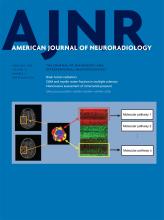Abstract
BACKGROUND AND PURPOSE: Cervical cord atrophy has been associated with clinical disability in multiple sclerosis and is proposed as an outcome measure of neurodegeneration. The aim of this study was to quantify the development of cervical cord atrophy and to evaluate its association with disability progression in patients with primary-progressive multiple sclerosis.
MATERIALS AND METHODS: Thirty-one patients with primary-progressive multiple sclerosis underwent 1.5T brain and spinal cord MR imaging at baseline and 6–7 years later. The cervical spinal cord from C1 to C5 was segmented to evaluate the normalized overall cross-sectional area and the cross-sectional area of C2–C3, C3–C4, and C4–C5. The annualized rates of normalized cross-sectional area loss were also evaluated. To estimate clinical progression, we determined the Expanded Disability Status Scale score at baseline and at 2 and 14 years after baseline to compute the normalized area under the curve of the Expanded Disability Status Scale and the Expanded Disability Status Scale changes from baseline to the follow-up time points. Associations between the cord cross-sectional area and brain MR imaging and clinical measures were also investigated. Finally, the value of all these measures for predicting long-term disability was evaluated.
RESULTS: Some normalized cross-sectional area measurements showed moderate correlations with the normalized area under the curve of the Expanded Disability Status Scale, ranging from −0.439 to −0.359 (P < .05). Moreover, the annualized rate of the normalized mean cross-sectional area loss and the baseline Expanded Disability Status Scale were independent predictors of long-term disability progression.
CONCLUSIONS: These data indicate that development of cervical cord atrophy is associated with progression of disability and is predictive of this event in patients with primary-progressive MS.
ABBREVIATIONS:
- aNMCSA
- annualized normalized mean cross-sectional area loss rate between the baseline and follow-up examination
- BPF
- brain parenchymal fraction
- CSA
- cross-sectional area
- EDSS
- Expanded Disability Status Scale
- NMCSA
- normalized mean CSA
- NCSA23
- normalized CSA at the C2–C3 level
- NCSA34
- normalized CSA at the C3–C4 level
- NCSA45
- normalized CSA at the C4–C5 level
- PPMS
- primary-progressive multiple sclerosis
- T1LV
- T1 lesion volume
- T2LV
- T2 lesion volume
- © 2018 by American Journal of Neuroradiology












